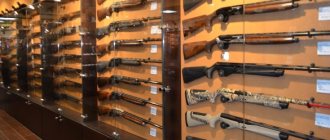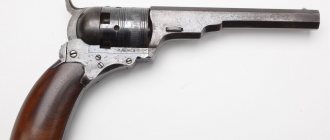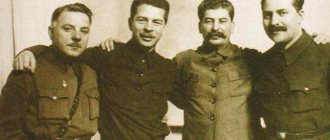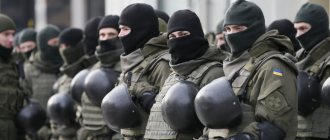Izhevsk rifles
IZH-27 have a stamp
Signs, brands and inscriptions on guns are of certain interest not only to gunsmiths, criminologists, historians, but also to the general mass of hunters.
Below, the marking features are given mainly in relation to the guns of the Izhevsk Mechanical Plant, however, the duration of action and their meaning are approximately the same for all hunting weapons in Russia.
All signs and inscriptions on the gun can be divided into several large groups:
1. Mandatory marking containing information about the caliber, manufacturer, etc.
2. Mandatory acceptance marks, which are actually called brands.
3. Technological markings and stamps, which carry the information necessary for organizing production.
4. Additional markings and inscriptions.
Let's look at these groups in more detail.
Mandatory labeling
in Russia currently includes the manufacturer's trademark, gun number, caliber and chamber length, nominal bore diameter, muzzle constriction of each barrel, symbol of the barrel steel grade, permissible operating pressure in the chambers.
The content of markings and inscriptions on guns is closely related to the traditions of gun production and the history of arms factories in the country, and in Izhevsk in particular.
The Izhevsk Mechanical Plant was founded in 1942 on the basis of part of the production of the machine-building plant. During that hot time for the country, on the outskirts of the city, equipment from the evacuated arms factories of Tula and Kovrov was placed in barracks. Before and after the war, the city's weapons workshops and the Gorpromkombinat were engaged in the repair and conversion of weapons from all kinds of rifled to smooth-bore. And now you can still rarely find such guns. For example, on one of the French Lebel repeating rifles with an under-barrel magazine of the 1886-93 model, converted into a 32-caliber shotgun, there is an inscription on the top of the barrel: NKMP RSFSR PLANT-HUNTING IZHEVSK 1940. And on the Mauser repeating rifle, also converted into a 32-caliber shotgun, the following is stamped on the top of the barrel: Izhevsk. Gorpromkombinat.32k.1951.
1.1. First of all, speaking about marking, we should remember the manufacturer’s trademark, which in earlier times was called the plant brand.
The production of hunting weapons at the mechanical plant began in 1949 with IZH-49 and ZK shotguns. The first gun produced was a virtually unchanged one of the Sauer models. Initially, its production immediately after the war was established at the Izhevsk Motorcycle Plant (factory N524, now JSC Aksion), where Maxim machine guns were manufactured during World War II. Of course, the guns of the motor plant had their own mark on the back of the butt and the barrel pads - a hexagon with an arrow. But then, due to a change in the production profile of the motorcycle plant, the production of the gun was transferred to the Izhevsk Mechanical Plant.
In those days, the brand of a mechanical plant was a shield with a five-pointed star depicted on it. The earliest shields had the letters "AES" around the star. Then these letters disappeared, and at the end of 1962, an arrow appeared instead of a star. It is precisely this trademark that now appears on the main part of the hunting weapons produced by the plant.
The trademark “Baikal” (“Baikal”) appeared in 1963 (certificate 22673 dated 03/06/63) and first belonged to the VO “Raznoexport”. All export hunting weapons of Russia were marked with it. The “Vostok” (“East”) sign was applied to export sporting weapons (certificate 22643 dated 02.20.63).
In Izhevsk, the “Baikal” sign was applied along with the plant’s brand until 1983, then the signs were divided: “Baikal” was for export, and a shield with an arrow was for the domestic market. But, due to the fact that export markings were allowed to be supplied to the domestic market, on the backs of the butts and barrels of many guns from the mechanical plant sold in Russia, there is a “Baikal” sign and the inscription “Made in the USSR” in English. In 1993, the rights to the Baikal trademark were transferred to Izhmekh, for example, on cartridges from the Krasnozavodsk Chemical Plant, it is applied only as agreed, despite the “huge distances” between the Kama and Baikal.
The marking of the shield from single-barrel barrels (applied on top of the barrel) was removed in 1986, from double-barrel barrels (applied on hooks and pads) - in 1984. After this, the shield image remained only for the domestic market and was placed on the backs of gun butts. But, it seems, through unofficial channels a certain number of guns with a shield instead of the “Baikal” did end up abroad, especially in the late 80s and early 90s.
In the first half of the 1990s, a new trademark appeared, on which the shield slightly changed its shape, becoming more rectangular. Such a shield can be seen on service, signal and gas pistols and revolvers, and household appliances of the plant. The old shaped shield remained on the guns.
1.2. Another mandatory marking for hunting weapons is a serial number and, applied simultaneously with the number, a symbol of the year of manufacture and testing of the gun.
Initially, the gun number was separated from the year of manufacture, although it was applied simultaneously with it. However, in the marking of the year of manufacture there was previously no uniformity; on some models the letter “g” was placed after the numbers, on others not. Separately, the year of manufacture was no longer marked in 1966, when marking of the year with conventional letters was introduced. In signs like AB0000, the first letter indicates the year, the second - the series, and the numbers - the number of the gun. Later, the letter part was reduced to one letter, which began to be used to encrypt both the year and the series of the gun. These letters changed annually, not only for the model as a whole, but also for each modification, so for IZH-27, IZH-27E or IZH-27E-1S the same letter denoted completely different years of production. In 1986, new year and number markings were introduced - the letters disappeared, leaving only numbers that have their own order. Of these, the first two digits of the number correspond to the last digits of the “year of manufacture and testing”.
1.3. Designation of choke constrictions.
Another mandatory marking is applied to the guns, indicating the magnitude of the difference in the diameters of the muzzle constriction. The peculiarity of this marking is that for muzzle expansion, not numbers, but the letters DR are used. The earliest marking of the choke began to be applied to the IZH-49 along with the caliber on the barrel cushions and was the letter “C” in a diamond under the line for the choke. The pay, therefore, was designated as “C/2”. The caliber was marked above the line - 16. Then, in later times, for each barrel, the nominal value of the diameters of the choke constrictions began to be marked, indicated above the line, and the nominal value of the bores - below the line.
In 1984, the international (English) Latin alphabet marking system was introduced.
Table 1.
| Muzzle device | Amount of contraction | Designation | Decoding | English designation |
| strong choke | 1.25 mm | T | for trench stand | trap |
| 3/4 choke | 0.75 mm | I.M. | improved | improved modified |
| pay | 0.5 mm | M | pay | modified |
| quarter choke | 0.25 mm | IC | improved | improved cylinder |
| cylinder | 0.0 mm | C | cylinder | cylinder |
| muzzle expansion (flare) | + 0.4 mm | DP(S) | for round stand | skeet |
In foreign catalogs, along with the above designation, there is also the designation of a strong choke XF (Xtra-Full) - “super-full”, a quarter choke as Light Modified - “light pay” and the decoding of the designation of the bell S as Spreader - “diffuser”.
Initially, the English letter S was placed on Izhevsk trunks with a bell, but in 1987. at the insistence of Tula it was replaced with two Russian DR.
1.4. The next mandatory marking is the marking of the gun model.
In fact, the index of a specific modification is marked, that is, not just IZH-27, but, for example, IZH-27M-1S. Likewise, at the Tula Arms Plant it is not always TOZ-34, but also TOZ-34ER.
1.5. Mandatory markings include the designation of the cartridge used - the caliber and length of the cartridge case.
Currently, an international system has been adopted, according to which the product of the caliber and the length of the cartridge case, rounded to whole millimeters, is written on one line. The marking will be indicated, for example, as 12x76, although the length of the 3″ chamber is 76.2 mm, or as 7.62x53R, where the letter R means that the cartridge case has a protruding flange.
1.6. Marking of the nominal value of the bore diameter.
Bore diameter was previously measured at a barrel length of 150 mm for the domestic market and at a length of 250 mm for export. The latter option is now accepted for all smooth-bore weapons.
1.7. Marking of the highest average value of the maximum gas pressure developed by cartridges during weapon operation.
1.8. The symbol for the grade of barrel steel is intended only for guns going for export, but in fact is placed on all guns. It looks like an elongated letter “C”, inside of which, depending on the elastic limit of the barrel steel, the letters “p” (from 46 to 71 kg/mm2) or “l” (more than 71 kg/mm2) are indicated.
Frivolous names for serious weapons
The tradition of naming weapons based on their external similarity to certain objects dates back to the 16th century. It was then that grenades appeared in the arsenal of the French army, and the soldiers, without thinking twice, gave them the name of the fruit - and they are similar in shape and the bursting of grenades into small fragments resembles numerous pomegranate seeds. The same applies to lemon. And the M9 anti-tank grenade launcher, which entered service with the American army during World War II, was named bazooka by soldiers after the musical instrument. At the same time, the most popular names were those that pointedly emphasized the deadly and threatening nature of machine guns, tanks, and missiles. All of us have heard about the German Panther and Tiger tanks. However, all this has a very distant relation to Russia, since our engineers, as always, went their own way. The names of Russian weapons are often unusual, witty, and sometimes even flirtatious. Sometimes you get the feeling that all the names of domestic self-propelled guns, rockets and anti-aircraft systems are a complete mockery of a potential enemy. Looking at the names of Russian military equipment and weapons, you understand that KVN could only have been born in this country.
For example, in Germany there is the Leopard tank, in Israel there is the Merkava (war chariot). In France there is the Leclerc tank, in America the Abrams, both are named after famous generals. We also have a modification of the T-72B2 “Slingshot” tank, named after the slingshot. Or another example from the field of artillery. The Americans called their self-propelled gun “Paladin”, the British “Archer” (Archer), everything seems to be clear. And if you look at domestic developments, there are only flowers: Carnations and Acacias, Peonies and Hyacinths, the latter, among other things, can fire nuclear weapons. Probably not a single potential enemy would dare to smell such a bouquet.
Self-propelled gun 2S5 "Gyacinth"
The same thing can be seen at the missile level, the American anti-tank missile is called “Dragon”, the other is called “Shilleyla” (bludgeon), everything is quite logical. However, we have our own approach - the 9M14M Malyutka ATGM, 9M123 Chrysanthemum, and the Metis anti-tank missile is equipped with a Mulatto night sight.
It is worth noting that flowers occupy a special place in the work of Russian designers. The Russian army has a whole “garden” in service. We have a 152-mm self-propelled gun “Hyacinth” (its second unofficial name “genocide” more accurately reflects the capabilities of the weapon). There is the "Pion" - a self-propelled gun with a 203-mm 2A44 cannon, there is the "Tulpan" - a 240-mm self-propelled mortar, the 2S1 "Gvozdika" and 2S3 "Akatsiya" self-propelled guns, as well as the 82-mm automatic mortar 2B9 "Vasilek", and that too not the whole bouquet yet. If we talk directly about the “Bouquet”, then this is the name of convoy handcuffs for 5 people.
Judging by other names, it can be noted that sentimentality is not alien to our military engineers. Apparently the dull grayness of army life weighs on them, so they yearn for romance and trepidation. This is probably why the direction-finding meteorological complex RPMK-1 is called “Smile”, the thermobaric warhead 9M216 is called “Excitement”, the 240-mm MS-24 rocket with a chemical warhead is “Laska”, the 122-mm rocket 9M22K with a cassette Warhead – “Decoration”. The UAZ-3150 “Shalun” vehicle, the MR-352 “Positive” shipborne radar and the 23-mm “Privet” rubber bullet deserve special mention. The same series includes the “Visit” body armor, the “Option” grenade launcher-shovel, the playful infantry shovel “Excitement,” the “Tenderness” handcuffs and the multiple-action flash-and-noise grenade “Ecstasy.”
grenade launcher "Option"
An equally popular topic for inspiration in the defense industry is the animal world. But here we are not talking about “cheetahs” and “tigers” (although to be fair, there are some in the Russian army), Russian designers are honest people. Of course, there are tigers in Russia, but very limitedly, only in the Far East, but there are a lot of squirrels, which is probably why the “Belka” is a 140-mm M-14S rocket, a 4TUD military reconnaissance radio station and a RM-207A-U target missile in one person. Our country also has "Boars" - a 96M6M multi-purpose target missile system, "Flies" - a 64-mm rocket-propelled anti-tank grenade RPG-18, "Raccoons" - a 533-mm homing torpedo SET-65, "Grasshoppers" - a mobile robotic complex of RTOs -2, “Canaries” – silent automatic grenade launcher system 6S1.
We call the experimental automatic grenade launcher TKB-0134 “Kozlik”, and the ground-based transportable DV-SV radio receiver R-880M “Shrimp”. Of the overseas animals, you can find in the Russian army the “Panda” - an N001VP radar sighting system for modifications of the Su-27, and the “Hummingbird” - a 324-mm aircraft anti-submarine torpedo. All this is crowned by the artillery reconnaissance and fire control complex 1L219 - “Zoo” and you know, there is even some logic here.
They played on the military and the eternal theme of health. That is why today the Russian army has at its disposal the BTR-80A “Buynost” armored personnel carrier and the R-410M “Diagnoz” heavy TRS station. In addition, there is a special medical vehicle for the airborne troops BMM-1D “Travmatism” and the software and hardware complex 65s941 “Tonus”.
UAZ 3150 “Scamp”
Military designers could not ignore the topic of professions, and judging by the names, many of them had previously worked in the field of journalism. A hint of this is the MKZ-10 “Subtitle” electronic compatibility complex, the “Gazetchik-E” radar protection device, and the somewhat ambiguous “Paragraph” - a 220-mm 9M27D propaganda rocket designed for the Uragan MLRS.
There are also references to other completely non-military professions in the names of military products. So, for example, the 30-mm aviation automatic cannon 9A-4071 is called “Ballerinka”, and the autonomous integrated secondary air traffic control and state recognition radar is called “Stewardess”. Some of the military designers were apparently very familiar with the work of the Courier, hence the name for the 15P159 mobile ground-based missile system with the small-sized RSS-40 ICBM.
There are also quite hospitable, native Russian notes in the name of our weapons, for example in the Gzhel body armor or the L-183-1 Bukovitsa electronic warfare testing equipment. These names are quite suitable for the formation of the Russian folk image. This also includes the immensely joyful names for the ICBM RT-23 UTTH (RS-22) “Molodets” and the heavy flamethrower systems TOS-1 “Buratino” and TOS-1M “Solntsepek”, as well as the 55-mm naval seven-barreled grenade launcher MRG-1 Ogonyok."
TOS-1 "Pinocchio"
Somehow, two more interesting systems stand apart in this row: the RPO-2 “Priz” hand flamethrower and the 9E343 “Semifinal” proximity fuse. Although in fairness both the first and second options contain certain hints to justify their name.
If you approach this issue seriously, you can figure out that the names of weapons are given in accordance with established traditions: - according to the modification letter: “Angara” - S-200A, “Vega” - S-200B, “Dubna” - S-200D etc. - by the name of the ongoing competitions or R&D: “Judge”, “Rook”. - by abbreviation: “Nona” - New Ground Artillery Weapon, “Kord” - Kovrov Gunsmiths-Dyagterevtsy, etc. - based on the logic of the series: self-propelled guns - “flower series”: “Peony”, “Hyacinth”, “Tulip”, etc.; air defense systems - “river series”: “Tunguska”, “Shilka”, “Neva”, “Dvina”; MLRS – various natural phenomena: “Hail”, “Hurricane”, “Tornado”, “Tornado”. - associative names: MANPADS - “Igla”, “Strela”; radio jamming complex “Moshkara”; camouflage sniper suits - “Kikimora” and “Leshy”. - army humor: sapper's shovel - "Excitement", handcuffs "Tenderness", shot for an under-barrel grenade launcher - "Foundling", heavy flamethrower system "Pinocchio". - in honor of the creators: the T-90 tank is named “Vladimir” (after the chief designer of the machine), the Antey-2500 air defense system (after the name of the creator company). - by pronounced action or property: fire extinguishing system “Frost” (sprays powder), dynamic protection “Contact” (triggered upon contact).
Sources used: www.ria.ru/defense_safety/20120330/609056634.html www.luzerblog.ru/post680 Materials from the free Internet encyclopedia "Wikipedia"
Mandatory acceptance marks.
A hallmark is a separate sign, distinct from a marking. If the marking contains information directly about the gun, then the mark confirms that this gun has passed the test and meets the requirements, primarily safety requirements.
2.1. The mark of testing the strength of weapons with reinforced shots.
Today, such a mark exists in two forms. The letter P, inscribed in a circle, is intended for smooth-bore hunting weapons (except for shotguns chambered for the Magnum cartridge). The same letter P, but in two concentric circles - for hunting smoothbore shotguns chambered for the Magnum cartridge and sports smoothbore weapons, since a more enhanced test is used for the second type of weapon. The custom of using this mark apparently has very old roots. The letter P or P in a circle, meaning the test mark “Tested,” was placed on the blades of the Zlatoust arms factory in 1837-1905, and in Tula, apparently, long before that. (see Kulinsky A.N. “Russian edged weapons of military, naval and civilian ranks of 1800-1917.” JV 1994, “Magic-PRESS”, “OLYMP”).
This mark began to be used on Izhevsk guns from the beginning of 1984 with the introduction of an industry standard for marking; on Tula guns it was also found earlier, at least on the TOZ-34 it was placed back in the 1970s and then meant increased testing of barrels. Along with it, marks were placed in the form of the letters K and U in circles - confirming tests, respectively, for accuracy and accuracy, and for enhanced testing of the gun, as well as the quality control department mark of the plant in the form of the connected letters T and K in a circle. Until 1984, other similar marks were placed in Izhevsk, for example, on the IZH-49, the mark for testing a gun with enhanced shots looked like the letter U in a trapezoid (“enhanced test”). Later the letter U was replaced by the letter N (“nitro test”). At first, each shot barrel of double-barreled guns was branded with the word “NITRO”, then a separate brand appeared - the letter N in a diamond. Combined "Squirrels" and single-barreled guns were branded with the letter H in a circle - apparently the tests of a smooth barrel and a gun were combined. Since 1980, by analogy with the marks on double-barreled guns, two marks have also been introduced on single-barreled guns to confirm the enhanced shooting of the barrel and the gun separately - the letter H in a rhombus and a trapezoid.
2.2. The mark of the State Testing Station, as an organization supervising weapons testing in the country, was introduced in 1966. It had the letters GIS outlined in a diamond shape. In fact, only acceptance and annual periodic tests of one gun of each model were carried out at the station, including shooting for guaranteed survivability. After the introduction of mandatory certification, the GIS stamp was replaced by the Mandatory Certification Mark and the Enterprise Test Station Mark (for the Izhevsk mechanical plant - an arrow in a circle). This was done on the IZH-27M gun around October 1993.
After the creation of the Udmurt Certification Center, since December 1996, instead of these two marks, the Mark of the Udmurt State Center is applied in the form of an arrow with wings in an oval, which is the recognized mark of the Brussels Convention. It is applied only to weapons that have been tested by enhanced shooting.
Other inscriptions and signs.
Since information about technological markings is extremely scarce and not so interesting, it remains to talk about signs that are mandatory only in some cases and about optional signs and inscriptions.
Typically this group includes the names of trading companies, the Quality Mark, the inscriptions “Made in Russia”, monograms of the owners and dedicatory inscriptions. Some of the additional markings are mandatory only for shotguns on the domestic market. The other part of the additional marking is mandatory only for export, but since the industry standard allows its presence for guns on the domestic market, this marking is placed on all guns - because it’s easier to make the tool and there’s no need to keep extra records. Of course, after entering the foreign market, Izhmekhzavod also tried to introduce international markings on all its weapons. At the same time, they practically stopped producing 16-gauge shotguns. In this regard, Tula have always focused on deep Russia and Siberia, producing, for example, TOZ-34 28 caliber in relatively large quantities.
4.1. The Quality Mark according to GOST 1.9-67 was assigned to different models of guns in different years, for example, on the IZH-26E, it began to be applied since 1970 only to guns intended for the domestic market of the country. This mark is not present on export-made guns sold in the Union. Canceled at the end of 1990.
4.2. The inscription “Made in the USSR” was applied only to the boxes of export-made shotguns, usually in Russian or, at the customer’s request, in English. In March 1992, the inscription was logically transformed into “Made in Russia.” May not be available on shotguns for the domestic market.
4.3. It is probably worth mentioning that manufacturers of double-barreled shotguns from the PMC countries mark their weight on the barrels, but this marking is not mentioned at all in the list of mandatory ones. The meaning of its application is completely unclear; it is not found on Russian-made guns.
4.4. Owner's signs. According to special instructions, inscriptions with the names of importing companies were applied to the barrels of individual batches of guns. For example, on one of the batches of IZH-81 shotguns, on the right side of the barrel, at the request of the customer, the following was written in laser:
IMPORTED BY CAI ST.ALB.VT
please read owners manual before firing
The last line translates to “before use, please read the instruction manual.” Such an inscription is now common not only for American hunting rifles.
Sometimes, for private orders at the factory (and not only), fancy monograms of the owner were applied to the cylinder or trigger guard of the gun. A monogram or dedicatory inscription can also be placed on a special plate embedded in the butt.
That's all that can be said briefly about the inscriptions on Izhevsk guns.
V. Valnev, weapons engineer
Read cyber fiction online on Phantom Worlds
HORIZONTALLY:
1. Sailing frigate of the Russian navy, in which I.A. took part in a circumnavigation of the world. Goncharov. 7 letters 4. Edged weapon of the natives, a sickle-shaped throwing club capable of returning to the launch site. 8 letters 8. People's Artist of Russia, whose heroine in the film V.V. Menshova “Moscow Doesn’t Believe in Tears” turned out to be the happiest of the three friends. 8 letters 12. A robber who ruins the population in places of war, taking things from the dead and wounded on the battlefield. 7 letters 20. A sticker that is a sign of confirmation of payment of any monetary fee - sending a letter, paying excise duty. 5 letters 21. The “poorest” character in Shakespeare’s “Hamlet”. 5 letters 22. “Communication without wires and distances” - that’s what A.S. called his invention. Popov. 5 letters 23. “I love... but with a strange love! My reason will not defeat her.” What word is missing in the poem by M.Yu. Lermontov? 7 letters 24. A hidden guard post, Captain Gray's ship, as well as carefully hidden information - all in one word. 6 letters 25. God of dying and resurrecting nature in ancient Egyptian mythology. 6 letters 26. A series of symbols on a computer keyboard or typewriter. 7 letters 27. Common name for sea monsters with tentacles - large octopuses and giant squids. 5 letters 28. A steel beam of a special section, laid on the superstructure of the track for the movement of railway rolling stock. 5 letters 29. Field bag of a cavalryman, an item of hussar equipment. 5 letters 30. An abundance of feelings that makes you cry. 7 letters 33. The self-name of this Indian people in the USA is translated as “real people”. 7 letters 36. A strong aperitif infused with wormwood, which gave the name to the painting by E. Degas. 6 letters 38. German politician, philosopher, historian and entrepreneur, one of the founders of Marxism. 7 letters 39. Evaporated grape juice, used in confectionery production, winemaking, and also as a nutritious and medicinal product. 6 letters 42. The father wrote the book “Brest Fortress”, and the son directed the film “Belorussky Station” - name the authors. 7 letters 45. American film director, one of the most prominent representatives of postmodernism in cinema - ... Tarantino. 7 letters 47. “Well, where ... - there is no reason for me there” (V.S. Vysotsky). 8 letters 49. Objects and phenomena that are characteristic of a certain area and unusual for others. 8 letters 53. The chain of shallows and coral islands between the Hindustan Peninsula and the island of Sri Lanka is called ... bridge. 6 letters 56. A method of hunting in which animals are driven to places where hunters sit in ambush. 6 letters 58. Nickname of the head of the mafia in the film L.I. Gaidai “The weather is good on Kulvet Deribasovskaya, or It’s raining again on Brighton Beach.” 6 letters 59. In Judaism and Christianity, the divine savior of humanity sent from above. 6 letters 60. The melody of carriage wheels, as well as the finishing material, artificial marble. 4 letters 61. Cutting and piercing weapons with a blade on the concave side of the blade among the peoples of the Near and Middle East. 6 letters 64. A philosophical direction that recognizes at the heart of the world two independent and equal principles: matter and spirit. 7 letters 65. Gemstone, symbol of innocence, firmness and courage. 5 letters 66. This is usually the name of a doctor who uses the methods of classical medicine in his work. 7 letters 67. Once - the monetary unit of a number of European countries, but now - only a collection of branches and leaves in the upper part of the plant. 5 letters 68. A voluminous, heavy antique book volume. 7 letters 73. Wild mountain sheep, the ancestor of the domestic sheep. 5 letters 74. A plucked string musical instrument that became most widespread in Austria and Germany in the 18th century. 5 letters 75. A small pot of incense, a talisman worn on the chest by superstitious people. 7 letters 76. A small giraffe that lives in the tropical forests of the Congo River basin. 5 letters 78. A doctor undergoing postgraduate practice in any medical institution. 6 letters 80. Thin cotton linen fabric, similar in production to linen. 6 letters 82. Famous poem by N.A. Nekrasov “General...” 8 letters 83. Georgian national flour product, pie stuffed with cheese and eggs. 8 letters 84. French writer, author of novels about Commissar Maigret. 7 letters 86. An artist whose works have lasting value. 7 letters 88. According to V.I. Dahl, this is a type of asbestos, mountain or stone flax. 6 letters 91. “... debt, fire and disease are capable of increasing again - destroy them completely” (unknown author). 7 letters 94. Queen of Georgia, to whom Sh. Rustaveli’s poem “The Knight in the Skin of a Tiger” is dedicated. 6 letters 98. A device for recording and storing data on magnetic tape. 7 letters 103. Small knight, nobleman in medieval Spain. 7 letters 105. Dense silk soft fabric with a smooth shiny front surface. 5 letters 106. A sloping section of a road, a railway track, an indicator of the steepness of the slope. 5 letters 107. People's Artist of the Russian Federation... Stepanovich Safronov. 5 letters 108. Warehouse for short-term storage of goods in a covered area at a station, customs office, or port. 7 letters 109. The British dubbed this plant of the buttercup family “monk’s hood,” and we call it a fighter. 6 letters 110. Waste from processing material with a saw or file. 6 letters 111. Paints ground on egg yolk or a mixture of adhesive solution and oil and diluted with water. 7 letters 112. Polite address to a married woman in France. 5 letters 113. What is the colloquial name for an employee of an enterprise who illegally takes something with him from production or work? 5 letters 114. What was the name of the Ministry of State Security of the GDR? 5 letters 115. System of state supervision over the press and media. 7 letters 116. What is another name for a padded jacket? 8 letters 117. Chemical or pharmaceutical product. 8 letters 118. Russian singer in the second generation, People's Artist of Russia. 7 letters
Also in this section:
Barrel steel and gun action
31.01.2015
Section: “About guns and more”
Of greatest interest is the question of how the hardness of the barrel affects the characteristics of the combat.
Read →










